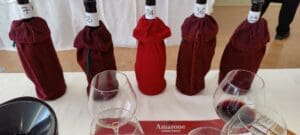Making wines is a tough job. Choosing a bottle of wine from rows of display shelves can be difficult. Drinking a good bottle of wine from an unsuitable wine glass is an act of blasphemy. During The Vintners’ Tour earlier we attended the Schott Zwiesel Master class conducted by Brand Ambassador, Sarah Mayo. Three lines of three glasses. Three wines to go with it. I shall therefore elaborate the remaining points in the order of three.
Consider this
Simple it seems but choosing wine glass requires consideration on the visual, delivery and weight. Among the many geek-y means of enjoying wines, the one I have grown to enjoy most is blind tasting, and this can very humbling. Performing sensory analysis against an in-memory dictionary of aroma, colours and emotions. With a quick glance, experienced drinkers gather quick information to make intelligent deduction of the variety, age and even the potential mouth-feel. Is this dark opaque, or light and clear? Can the glass present the rim colour with full brilliance? Obviously the visual inspection can’t work with an opaque black glass.
Putting the smell and taste departments into action. Is a wine too sweet with this glass and too sour the next? Does the wine punch your nose with alcohol, and yet undetectable from a bigger vessel? Is this too heavy and bulky for swirling? Will swirling decorate your bespoke white shirt with artistic purple dots?
Wine, behave yourself!
Like a good partner (by multiple definitions of the word), a fitting wine glass brings out the best and conceals the flaws. It stands humble on the table and constantly compliment the protagonist. Therefore to understand a glass, we need to be technical with its components. From top to bottom, the names are bowl, stem and base.
Within the bowl is a three-dimensional space defined by girth (diameter), height and the mouth size. Wide girth translates to a bigger surface area which can aid the evaporation of alcohol. Hitching a ride on the vaporised alcohol, aromatic compounds (including ester) are carried from the wine and suspended in the space within. Since the aromatic compounds have varying weight and density, to escape is dependent on the height and mouth opening size. And of course, a deep nosy sniff from the glass lends a jail breaking hand.
Bringing the glass to the lips, the thickness of the rim has a direct influence on the flow of the wine. A thicker rim tends to let the wine flow towards the middle and back of the palate. This works for low acid wines since the sour-senses are along the lateral sides. A thinner rim brings the wine to the tip of the tongue, and this helps to detect any signs of sweetness from dry wine. Doing this in reverse will result in sensory overloading and fatigue will set in quickly like the theatre curtains.
On the market, glasses are categorised either as normal glass or crystal glass. The latter – which is not real crystal – is an ‘alloy’ of silicon with metallic compound. Beautiful as they are, their pricing are equally noble. Crafted thin and light, the decorative properties, owing to the brilliance, allow the ‘shine’ and making colour contrast more visible. Normal glasses are usually made thicker, due to the natural viscosity they possessed, and it can interfere with the vibrancy and makes the wine less visually attractive.
But for those who are interested to own beautiful durable crystal wine glass, options are available. One being the Schott Zwiesel Tritan series. Utilising the toughness of Titanium and Zirconium, the Tritan glasses are safe for dishwasher and organic clumsiness. During the event, sales representative from Schott Zwiesel was extremely keen to drop the glass. But all we asked was a loud clink. By the way, clinks can shatter glasses, easily.
So during the master class Sarah introduced us to three range of glasses. The Vina, Cru Classic and The First. Tasting the same wine together in all three glasses was enlightening. Cru Classic, a much taller glass with broad opening on top, gave very subtle primary aroma. At other times the wines can be almost mute. On other hand The First with its tapered body, funnelled the aroma towards the aroma receptors, allowed the aroma and bouquet to be immediately pronounced.
If I can only buy one set of glasses among the three, The First is a clear winner. The perfect combination of a wide girth at the bottom, tapered side and small mouth opening makes this a highly versatile glass for both white and red. The only deterrent is the price.




